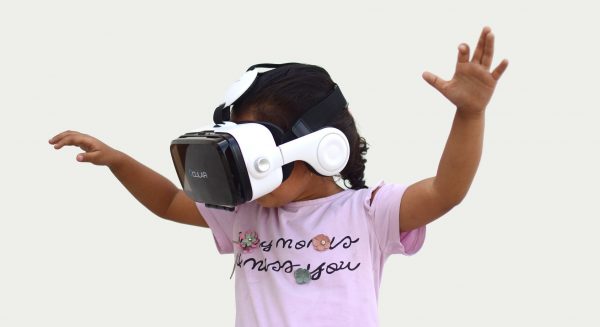Wie Sie Virtual und Augmented Reality Content für das Web aufbereiten können.
Mit der konsequenten Einführung verschiedener Enabling Devices steht Virtual Reality (VR) vor der nächsten Welle, die populär wird. Als technisches Teilgebiet von VR bereitet sich Augmented Reality (AR) auch auf seine zunehmende Ausbreitung auf der Basis von deutlich stabilisierten Computer-Vision-Technologien vor. Die weit verbreitete Nutzung von VR/AR führt zu einem Ökosystem mit einer skalierbaren Content-Plattform als Zentrum. Die Plattform wird die effiziente Produktion unterstützen und einen breiten Vertriebskanal bieten.

Das Web wurde in den letzten zwei Jahrzehnten als skalierbare Content-Plattform öffentlicht qualifiziert. Seine Designprinzipien, bestehend aus Einfachheit, Modularität und Dezentralisierung, haben es ermöglicht, verschiedene Inhalte durch die Wiederverwendung vorhandener externer Ressourcen einfach zu erstellen, die Inhalte einfach nur durch Einfügen in einen Webserver zu veröffentlichen und die Inhalte zur Laufzeit auch von Endbenutzern nach der Verteilung dynamisch zu aktualisieren. Und es besteht kein Zweifel, dass diese Fähigkeiten aus HTML und seinen zugrundeliegenden Prinzip, der Web-Architektur, entstanden sind.
Viele Contentspezifikationen für VR/AR, die versuchen, webfreundliche Ansätze zu verfolgen, hatten jedoch Schwierigkeiten, einen Konsens zu erzielen, da ihre unabhängigen Strukturen nicht mit der Webarchitektur kompatibel waren und es schwierig war, die Vorteile des Web-Ökosystems zu nutzen. Wir glauben, dass Web-Technologien, um VR/AR als Content-Plattform zu unterstützen, die Anforderungen an VR/AR in ihren Kernspezifikationen gemäß der Web-Architektur verschmelzen müssen.
In dem folgenden Beitrag möchten wir mit ihnen Erkenntnisse aus der Entwicklung eines mobilen AR-Webbrowsers austauschen.
Virtual und Augmented Reality Content für das Web aufbereiten.
Das aktuelle Modell zur Erstellung von VR/AR-Anwendungen für das Web basiert hauptsächlich auf einer Weiterentwicklung traditioneller Programmierer-Frameworks für Computergrafiken auf WebGL-Basis. In diesem Modell sind Anwendungen:
- Eingeschränkte Funktionalität – Obwohl 3D-Content in Webbrowsern angezeigt werden können, sind sie aufgrund der getrennten Handhabung mit anderen HTML-Elementen nicht nahtlos in das bestehende Web-Ökosystem integriert. Benutzer möchten die bestehende Web-API oder Widgets (z.B. Google Maps, jQuery), die vielseitige Funktionen und Live-Datenfeeds in die von ihnen erstellte virtuelle Welt bereitstellen, vermanschen oder umgekehrt.
- Keine Möglichkeit, auf die reale Welt zu verweisen: Es gibt keine offizielle Möglichkeit, die Erkennungsdaten für Objekte und Orte in der realen Welt (z.B. Feature-Deskriptoren für den visuellen Bildabgleich und -verfolgung) für AR-Webanwendungen zu verarbeiten.
- Separater Rendering-Kontext – Wie typische HTML-Inhalte müssen auch VR/AR-Inhalte den Rendering-Kontext (z.B. Ansichtsportgröße, Skalierung) kennen, um regelbasiertes dynamisches Layout (z.B. Media Query) oder Level of Detail (LOD) anzuwenden. Der auf WebGL basierende 3D-Kontext wird jedoch innerhalb des Canvas-Elements zusammen mit dem 2D-Kontext isoliert und getrennt vom Rendering-Kontext anderer Elemente verwaltet.
Die Grundlagen des VR/AR müssen sich im Hinblick auf die Aufbereitung derartige Inhalte für das Web weiterentwickeln. Die Grundbausteine und Betriebsmechanismen sind entsprechend der Art der Webarchitektur organisiert. Im Gegensatz zum traditionellen Computergrafikansatz sind auf das Web optimierte AR/VR-Anwendungen:
- Mashbar – VR/AR-Content und bestehende Web-Elemente werden nahtlos in einer einzigen Web-Anwendung zusammengefasst. Dadurch könnte ein HTML-Element in ein 3D-Objekt eingebettet werden und sich gegenseitig beeinflussen. Darüber hinaus können verschiedene externe Frameworks (z.B. Web of Things, Payments und jQuery) zu AR/VR-Inhalten hinzugefügt werden.
- Verweis auf die reale Welt – Wie Bilder und Videos können AR-Webanwendungen einfach die realen Entitäten deklarieren, die Autoren durch Verweis auf ihre URLs erkennen möchten und die Erkennungsdaten (z.B. Feature-Deskriptoren) werden vom Browser geladen und in seine interne Tracking-Engine injiziert.
- Reagiert sowohl auf die virtuelle als auch auf die reale Welt – der Renderer des Browsers passt sich selektiv an die Seite, virtuelle und reale Welt an. Das Seitenmodell ist eine traditionelle Browsermetapher, die auf einer 2D-Ebene basiert, um ein HTML-Dokument auf einem Bildschirm darzustellen. Für VR wird das Ansichtsfenster des Browsers als das gleiche wie eine Kamera in der 3D-Szene betrachtet (über die WebVR-API angesprochen). Für AR werden die Tracking-Daten von realen Objekten und Orten auf den Rendering-Kontext des Browsers angewendet.
Anforderungen und Möglichkeiten der Standardisierung.
Um die oben skizzierte auf das Web optimierte AR/VR Content Vision zu realisieren, gibt es mehrere Anforderungen und Möglichkeiten der Standardisierung wie folgt:
- Entwicklung von HTML für VR/AR – Um VR/AR-Content und schon länger bestehende Webinhalte miteinander zu vermischen, ist es notwendig, dass VR/AR-Inhalte zu einem erstklassigen Erlebnis in HTML werden. Um dies zu erreichen, ist eine deklarative 3D-Spezifikation erforderlich, die vollständig HTML-konform ist. VR/AR-Inhalte sollten von Browsern mit typischen HTML-Elementen in einem einzigen DOM-Tree auf die gleiche Weise behandelt werden.
- „Physische Dinge“ als Ressourcen – Um die AR-Erkennung im Web zu ermöglichen, werden alle Zielobjekte der realen Welt, einschließlich physischer Objekte und Orte als Ressourcen betrachtet und sollten über Standard Universal Resource Identifiers (URIs) zugänglich sein, um Feature-Deskriptoren zur Identifizierung und Tracking bereitzustellen. In unserer Implementierung werden sie als Wert für die angegebene CSS-Eigenschaft in der AR-Webanwendung deklariert.
- Neuer Medientyp für VR/AR – Die Trennung von Rendering-Kontexten zwischen VR/AR-Szene und Page konnte im Hinblick auf das Responsive Web angesprochen werden. Die verschiedenen Renderer können dynamisch zugewiesen werden, indem New CSS Media Typen für VR/AR oder sogar Unified Renderer für Mixed Reality (MR) hinzugefügt werden. CSS Media Query enthält eine einen Medientypspezifikation, um verschiedene Stylesheets auf verschiedene Rendering-Methoden anzuwenden (z.B. Sprache, Braille geprägt etc.). In unserer Implementierung haben wir die „Place“-Medien definiert und der AR-Rendering-Modus und die Vision-Tracking-Engine werden ausgelöst, wenn sie in einem HTML-Dokument deklariert werden.
Schlußfolgerungen.
Die VR/AR für Web verspricht eine der faszinierendsten technologischen Herausforderungen zu werden. Das Ausmaß und die Gesamtauswirkungen dieses aufkommenden Feldes sind erschütternd. Wir glauben, dass die Standardisierungsbemühungen entscheidend für den Erfolg und die Fähigkeit sein werden, sie auf ihr volles Potenzial zu bringen. Es gibt viele Bereiche für die Standardisierung im VR/AR fürs Web und wir sind sehr daran interessiert an diesem Workshop teilzunehmen und mitzuwirken. Wir glauben, dass eine der kritischen Domains die Definition eines Standardentwicklungs-, Bereitstellungs- und Managementmodells für VR/AR-Webanwendungen ist, einschließlich der formalen Definition von physischen Dingen, Medientypen und den zugehörigen Datentypen.
Vielen Dank für ihren Besuch.


